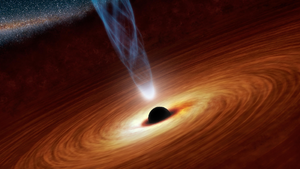Difference between revisions of "Black Hole"
| Line 15: | Line 15: | ||
:[https://www.amazon.co.uk/gp/product/1782945970/ref=as_li_tl?ie=UTF8&camp=1634&creative=6738&creativeASIN=1782945970&linkCode=as2&tag=nrjc-21&linkId=a120d24dcc7cc7a58192069a3aafc1d2 ''Black holes, page 319, GCSE Physics; The Complete 9-1 Course for AQA, CGP, AQA ''] | :[https://www.amazon.co.uk/gp/product/1782945970/ref=as_li_tl?ie=UTF8&camp=1634&creative=6738&creativeASIN=1782945970&linkCode=as2&tag=nrjc-21&linkId=a120d24dcc7cc7a58192069a3aafc1d2 ''Black holes, page 319, GCSE Physics; The Complete 9-1 Course for AQA, CGP, AQA ''] | ||
:[https://www.amazon.co.uk/gp/product/019835939X/ref=as_li_tl?ie=UTF8&camp=1634&creative=6738&creativeASIN=019835939X&linkCode=as2&tag=nrjc-21&linkId=57e96876985fc39b1a3d8a3e3dc238b6 ''Black holes, pages 234-235, GCSE Physics; Third Edition, Oxford University Press, AQA ''] | :[https://www.amazon.co.uk/gp/product/019835939X/ref=as_li_tl?ie=UTF8&camp=1634&creative=6738&creativeASIN=019835939X&linkCode=as2&tag=nrjc-21&linkId=57e96876985fc39b1a3d8a3e3dc238b6 ''Black holes, pages 234-235, GCSE Physics; Third Edition, Oxford University Press, AQA ''] | ||
| + | ====Edexcel==== | ||
| + | :[https://www.amazon.co.uk/gp/product/1292120223/ref=as_li_tl?ie=UTF8&camp=1634&creative=6738&creativeASIN=1292120223&linkCode=as2&tag=nrjc-21&linkId=068ecf40278c32406a7f1c6e66751417 ''Black holes, page 123, GCSE Physics, Pearson Edexcel ''] | ||
| + | :[https://www.amazon.co.uk/gp/product/1782948163/ref=as_li_tl?ie=UTF8&camp=1634&creative=6738&creativeASIN=1782948163&linkCode=as2&tag=nrjc-21&linkId=0fdbfd5dd397d6e24a9dfb250f08587f ''Black holes, page 188, GCSE Physics, CGP, Edexcel ''] | ||
==Beyond the Curriculum== | ==Beyond the Curriculum== | ||
{{#ev:youtube|https://www.youtube.com/watch?v=kOEDG3j1bjs}} | {{#ev:youtube|https://www.youtube.com/watch?v=kOEDG3j1bjs}} | ||
{{#ev:youtube|https://www.youtube.com/watch?v=e-P5IFTqB98}} | {{#ev:youtube|https://www.youtube.com/watch?v=e-P5IFTqB98}} | ||
Revision as of 14:30, 2 November 2019
Contents
Key Stage 4

An artist's impression of a black hole with matter spiraling in towards it and a jet of plasma sent out the top due to the extremely intense magnetic field.
Meaning
A black hole is the last stage in a high mass star's life in which the core has collapsed into a point so small that the gravity becomes so intense that not even light can escape.
About Black Holes
- Only the most massive stars become black holes.
- Black holes can be very small, only a few kilometers across, but they are extremely massive.
References
AQA
- Black hole, pages 285, 290, GCSE Physics; Student Book, Collins, AQA
- Black holes, page 100, GCSE Physics; The Revision Guide, CGP, AQA
- Black holes, page 252, GCSE Physics, Hodder, AQA
- Black holes, page 319, GCSE Physics; The Complete 9-1 Course for AQA, CGP, AQA
- Black holes, pages 234-235, GCSE Physics; Third Edition, Oxford University Press, AQA
Edexcel
- Black holes, page 123, GCSE Physics, Pearson Edexcel
- Black holes, page 188, GCSE Physics, CGP, Edexcel